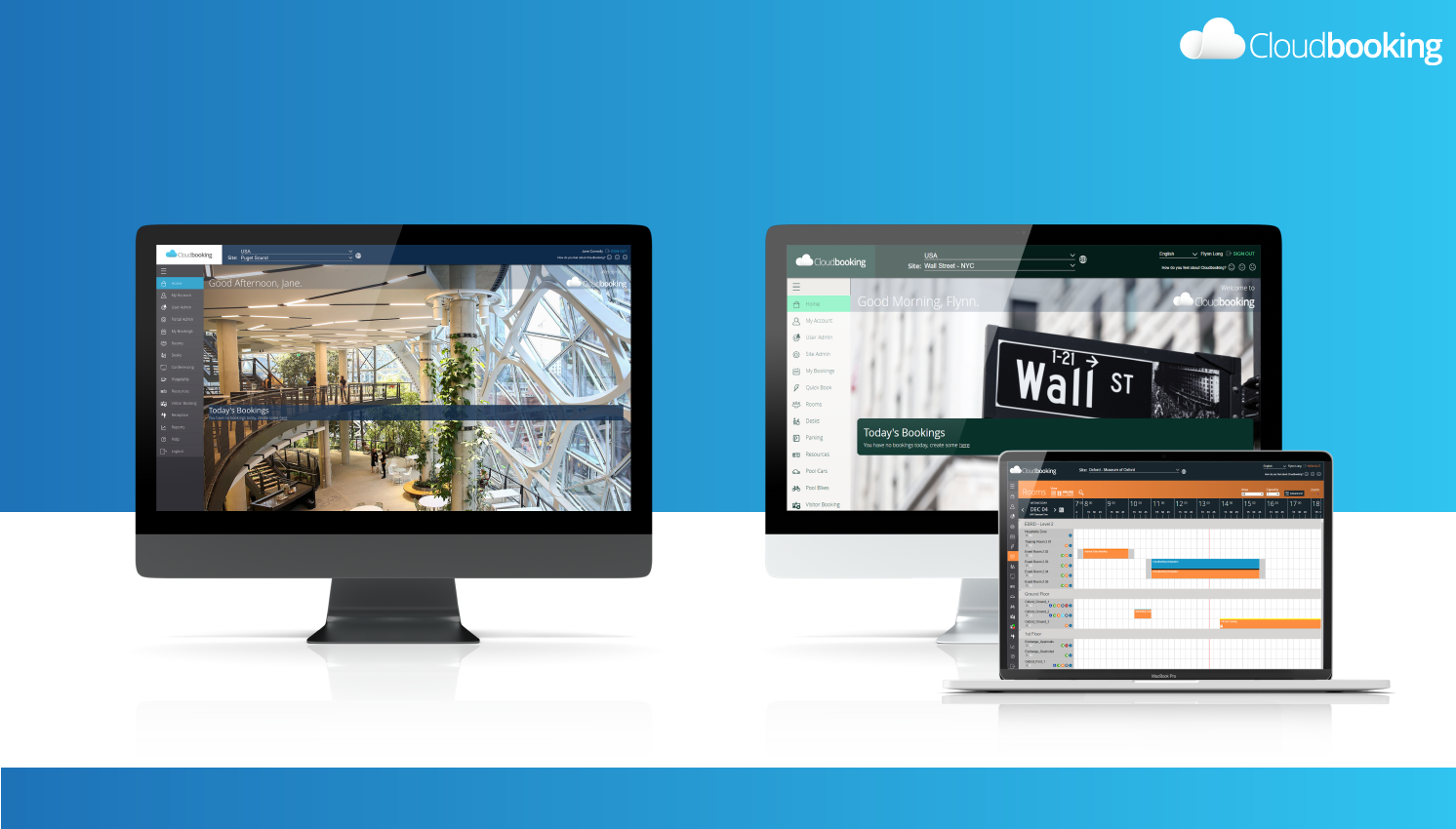
In the post-pandemic world, organizations are increasingly switching to an agile working model and redesigning their offices to reflect new ways of working. Activity-based workspaces are becoming increasingly popular because they cater to employees’ conventional needs and desires, helping to enhance company culture and promote productivity.
Offices are increasingly being used solely where collaboration is required for a variety of purposes. Where work can be completed independently, people are working from home. They are traveling to the office for teamwork, meetings, collaboration, and socializing. As such, organizations should be looking to redesign their workspaces to incorporate both informal and formal meeting spaces, which can be pre-booked using a meeting room booking app.
Get a free demo
Enquire about a no-obligation demo today and get an exclusive hybrid working research paper — for free. Created in partnership with YouGov, this invaluable guide provides essential insights into developing your own effective hybrid strategy. Click below.
The Different Types of Informal Spaces
Informal workspaces can be designed exclusively for socializing and collaboration or include equipment and tools for working. These spaces can be pre-bookable on meeting room booking software or open to all.
There are different types of informal meeting spaces, and these include:
- Breakout spaces
- Huddle rooms
- Creative spaces
- Collaboration spaces
- Coffee spaces
- Fun zones
Organizations may have any number and combination of informal meeting spaces depending on the size and nature of the company. These spaces should be designed for purposes that match the needs of the employees working within the organization. The company culture, or desired culture, should be central to the design of informal spaces.
Pros and Cons of Informal Spaces
Informal spaces can be fantastic for enhancing the workplace culture. Organizations redesigning their office space to meet conventional demands should look to incorporate informal spaces into a broader, activity-based design that supports agile working.
Nowadays, employees are increasingly demanding flexibility in the way they work. They want the freedom to choose when, how, where, and with whom they work. Since the global pandemic, more organizations are permanently encouraging home working at least some of the time. While this has its benefits, it can also have drawbacks if they are not adequately compensated.
Providing informal meeting spaces enhances the social aspect of the office while promoting collaboration which can sometimes be hindered by home working. It’s all about agility these days; organizations must balance home working with in-office days to get the best out of employees. Creating the right workspaces is central to this.
Informal meeting spaces, such as huddle spaces, collaboration rooms, and social spaces, encourage employees to interact with their colleagues. These spaces promote relationship building and improved communication amongst team members. They help to foster collaboration in a relaxed, comfortable environment, and this encourages creativity.
One of the main benefits of informal spaces is that they are incredibly versatile. They can be used for both social gatherings and work purposes. The social aspect helps enhance company culture and foster a sense of inclusion and belonging. This, in turn, helps to attract and retain talent, which is crucial in the age of The Great Resignation.
For work purposes, these more relaxed spaces can be used for informal meetings. The majority of meetings within a workplace are of this nature, so it’s good to create spaces that facilitate this. This may include meetings for brainstorming, team catch-ups and briefings, and collaboration on projects.
However, an office should not consist entirely of informal meeting spaces because there can be some downsides to this way of working. Because these spaces are inherently relaxed and social, they are not ideal for situations when serious issues need to be discussed, when privacy is required to discuss sensitive matters or when important decisions must be made.
In some cases, informal spaces can induce a slower pace of work or provide distractions for employees. They are, therefore, not always the best bet when working towards strict deadlines.
The Different Types of Formal Meeting Spaces
Formal meeting spaces are designed for specific purposes. They should be pre-bookable on meeting room booking software and fully equipped with the right equipment. This may include a large meeting table, monitors, and projectors.
There are different types of formal meeting spaces, and these include:
- Conference rooms
- Large meeting rooms
- Small meeting rooms
- Executive offices
- Interview rooms
Every organization – or at least medium to large organizations – should have at least one formal meeting space. Generally speaking, the larger the organization, the more formal meeting spaces are required. Large organizations will almost certainly need larger formal meeting spaces, such as conference rooms, for example. In contrast, smaller organizations may have one or two formal meeting rooms to accommodate up to ten people.
When designing formal meeting spaces, organizations should consider how many employees they have, what purposes the rooms will serve, and how frequently they will be used. Formal meeting spaces tend to be quite plain and uniform in design to remove possible distractions and promote focus and professionalism.
Pros and Cons of Formal Spaces
Formal meeting spaces are a must-have in any office design. Organizations should have at least one formal space for meeting room booking. These spaces provide a private, quiet and professional space to hold company meetings. This may include conferences, board meetings, managers’ briefings, and formal team meetings.
Formal meeting spaces are suitable for employees at all levels of the organization. However, they are typically used most frequently by those at the top levels of the organizational hierarchy. Those in higher-level positions require spaces to hold serious, professional meetings. Formal meeting rooms provide a suitable space for when privacy and focus are needed.
When compared to informal meeting spaces, formal meeting spaces are free from distractions and equipped for the specific purpose of holding a meeting. They are the ideal environment for formal meetings, where there is a pre-arranged agenda and minutes are taken.
Formal meeting spaces are also ideal for meeting with external visitors as they provide a professional image of the company. They are necessary when dealing with confidential issues, such as disciplinaries, interviews, or discussions around classified information. To hold such meetings in an informal space would be unprofessional and may compromise compliance and data protection.
However, to solely create formal meeting spaces in an office environment could have some downsides. Because these spaces are inherently formal and professional, they are not ideal for project collaboration or brainstorming sessions because they are not designed to promote creativity.
In addition, formal spaces do not facilitate socializing well and do nothing to enhance company culture. When showing prospective employees around the office, they may be enticed by informal areas, but it is unlikely they will be impressed by formal meeting rooms. After all, these formal spaces show nothing of the character of an organization and are present in virtually every office in the world.
Informal and Formal Meeting Room Booking
In the age of agile working, employees are increasingly taking ownership over their work schedules. In the past, it may have been the role of management to schedule meetings, send invitations, and tell their team members where they should be at any given time and day. However, this is all changing due to the flexible working revolution.
Nowadays, employees must organize their own work schedules and book adequate in-office workspaces in advance. Typically, today’s workers seek to work from home on individual tasks and attend the office for collaboration, meetings and socializing. This is why it’s essential to incorporate informal and formal meeting spaces into an office design.
Meeting room booking software can equip workers with the scheduling tools they need to pre-book an appropriate workspace on any given day and time. With a user-friendly app, an employee can check meeting space availability, locate colleagues and book the spaces they need ahead of schedule.
Meeting room booking systems allow managers and team leaders to book formal spaces for meetings, send invitations and alert the relevant people. This information can then be viewed by administrators and facilities, which can help with the room setup and any other requirements.
Informal meeting spaces can also be pre-booked using meeting room booking software so employees can pre-arrange team meetups and collaboration days. This helps bring together an otherwise dispersed team and keep everyone on the same page. Workers can use this software to organize their weekly working schedule by locating employees, viewing workspace availability, and diarizing accordingly.
Conclusion
To get the best out of an agile workforce, organizations should design their office space to incorporate a mix of informal and formal meeting spaces. It would be detrimental to productivity and the company culture to focus on one, to the exclusion of the other. Having a variety of workspaces gives employees choice over how, where, and with whom they work. It helps to enhance their office experience and, in turn, boost employee satisfaction and productivity.
Meeting room booking systems allow workers to pre-book an appropriate workspace depending on the task they need to get done. This software aids in space management and provides valuable insights into space utilization while coordinating dispersed teams.
Let Cloudbooking help you to create formal and informal spaces in your workplace with our meeting room booking software. Contact us now for a no-obligation product demo.


